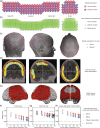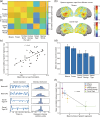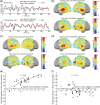Mapping brain function in adults and young children during naturalistic viewing with high-density diffuse optical tomography
- PMID: 38703090
- PMCID: PMC11069306
- DOI: 10.1002/hbm.26684
Mapping brain function in adults and young children during naturalistic viewing with high-density diffuse optical tomography
Abstract
Human studies of early brain development have been limited by extant neuroimaging methods. MRI scanners present logistical challenges for imaging young children, while alternative modalities like functional near-infrared spectroscopy have traditionally been limited by image quality due to sparse sampling. In addition, conventional tasks for brain mapping elicit low task engagement, high head motion, and considerable participant attrition in pediatric populations. As a result, typical and atypical developmental trajectories of processes such as language acquisition remain understudied during sensitive periods over the first years of life. We evaluate high-density diffuse optical tomography (HD-DOT) imaging combined with movie stimuli for high resolution optical neuroimaging in awake children ranging from 1 to 7 years of age. We built an HD-DOT system with design features geared towards enhancing both image quality and child comfort. Furthermore, we characterized a library of animated movie clips as a stimulus set for brain mapping and we optimized associated data analysis pipelines. Together, these tools could map cortical responses to movies and contained features such as speech in both adults and awake young children. This study lays the groundwork for future research to investigate response variability in larger pediatric samples and atypical trajectories of early brain development in clinical populations.
Keywords: brain development; feature regressor analysis; functional near‐infrared spectroscopy; movie viewing; optical neuroimaging.
© 2024 The Authors. Human Brain Mapping published by Wiley Periodicals LLC.
Conflict of interest statement
The authors declare no conflicts of interest.
Figures






References
-
- Arichi, T. , Fagiolo, G. , Varela, M. , Melendez‐Calderon, A. , Allievi, A. , Merchant, N. , Tusor, N. , Counsell, S. J. , Burdet, E. , Beckmann, C. F. , & Edwards, A. D. (2012). Development of BOLD signal hemodynamic responses in the human brain. NeuroImage, 63(2), 663–673. 10.1016/j.neuroimage.2012.06.054 - DOI - PMC - PubMed
-
- Black, M. H. , Chen, N. T. M. , Iyer, K. K. , Lipp, O. V. , Bölte, S. , Falkmer, M. , Tan, T. , & Girdler, S. (2017). Mechanisms of facial emotion recognition in autism spectrum disorders: Insights from eye tracking and electroencephalography. Neuroscience and Biobehavioral Reviews, 80(December 2016), 488–515. 10.1016/j.neubiorev.2017.06.016 - DOI - PubMed
-
- Blasi, A. , Mercure, E. , Lloyd‐Fox, S. , Thomson, A. , Brammer, M. , Sauter, D. , Deeley, Q. , Barker, G. J. , Renvall, V. , Deoni, S. , Gasston, D. , Williams, S. C. R. , Johnson, M. H. , Simmons, A. , & Murphy, D. G. M. (2011). Early specialization for voice and emotion processing in the infant brain. Current Biology, 21(14), 1220–1224. 10.1016/j.cub.2011.06.009 - DOI - PubMed
-
- Boto, E. , Shah, V. , Hill, R. M. , Rhodes, N. , Osborne, J. , Doyle, C. , Holmes, N. , Rea, M. , Leggett, J. , Bowtell, R. , & Brookes, M. J. (2022). Triaxial detection of the neuromagnetic field using optically‐pumped magnetometry: Feasibility and application in children. NeuroImage, 252, 119027. 10.1016/j.neuroimage.2022.119027 - DOI - PMC - PubMed
Publication types
MeSH terms
Grants and funding
LinkOut - more resources
Full Text Sources
Research Materials

